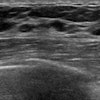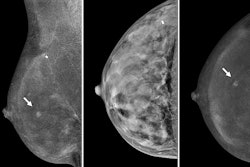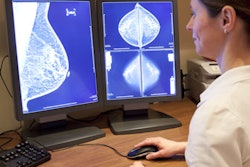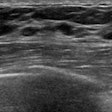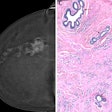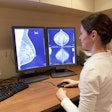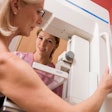Kaiser scoring for contrast-enhanced mammography (CEM) demonstrated comparable diagnostic accuracy to that of MRI in distinguishing breast masses, according to a study published October 11 in Academic Radiology.
Researchers led by Bei Hua, PhD, from First Hospital of Hebei Medical University in China also found that applying Kaiser scoring for CEM combined with suspicious malignant microcalcifications can improve diagnostic efficiency for breast masses. However, detection of edema did not significantly improve performance when using this machine-learning method.
“Our study demonstrated that the Kaiser score for CEM could be utilized as a decision rule for the differential diagnosis of breast masses, similar to the Kaiser score for MRI,” Hua and co-authors wrote.
The Kaiser score is a machine learning-derived decision rule for characterizing breast lesions in a clinical setting and screening for breast cancer. The score has primarily been used on breast MR images.
However, CEM in recent years has emerged as a potential alternative to breast MRI, with proponents highlighting the easier access and comparable diagnostic accuracy compared with what CEM presents. CEM can also be useful for patients who have MRI contraindications.
Hua and colleagues explored how the Kaiser score can be applied to interpreting breast masses on CEM. They analyzed Kaiser scores for calcifications and edema and compared the results to the diagnostic accuracy of MRI.
The study included data collected between 2019 and 2022 from 275 women with enhanced breast masses. The team divided the study cohort into benign and malignant groups based on pathological diagnosis.
Kaiser scores for CEM demonstrated significantly higher area under the curve (AUC) values than that of BI-RADS and comparable accuracy to that of MRI.
| Kaiser score performance with CEM, MRI | |
|---|---|
| Kaiser score-modality combination | AUC |
| Kaiser score-CEM | 0.878 |
| Kaiser score (calcification)-CEM | 0.934 |
| Kaiser score (edema)-CEM | 0.87 |
| Kaiser score-MRI | 0.876 |
| Kaiser score (apparent diffusion coefficient)-MRI | 0.875 |
| BI-RADS-CEM | 0.691 |
| *The AUC of Kaiser score-CEM achieved statistical significance compared to BI-RADS-CEM (p < 0.001). Kaiser score-CEM measures were comparable to Kaiser score-MRI measures (p > 0.05 for all). | |
The team also found that the following characteristics showed significant differences between benign and malignant microcalcifications: aging characteristics of root sign, time-signal intensity curve (TIC/mTIC), margin, internal enhancement pattern (IEP), edema, apparent diffusion coefficient values, and suspicious malignant microcalcifications (all p ≤ 0.011).
Finally, the detection rate of root sign and margin showed substantial agreement between CEM and MRI (κ = 0.656 and 0.64, respectively). However, IEP, TIC/mTIC, and edema showed poor agreement (κ = 0.38, 0.32, and 0.324, respectively).
The study authors highlighted that CEM could increase the detection rate and decrease the misdiagnosis rate, as well as have a diagnostic efficiency like that of breast MRI.
“The integration of morphology, enhancement, and microcalcification information for Kaiser score [calcification]-CEM improved diagnostic efficiency compared to Kaiser score-CEM in all lesion groups,” they added.
The full results can be found here.

